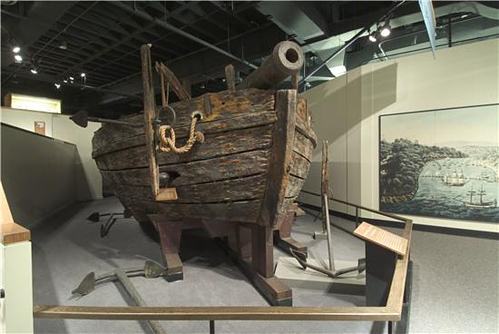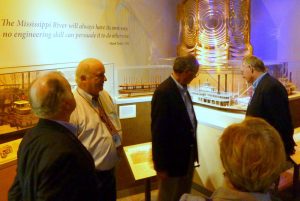The Sailing Club of the Chesapeake, to commemorate the American Bicentennial, invited members of England’s Royal Yachting Association to journey to the Eastern Seaboard for the “No Hard Feelings Cruise.” Sixty-two British sailors took up the offer, and with more than 300 others, embarked on eighty-nine yachts to race and explore the waters of the Chesapeake Bay in 1976.
It was such a success that the opportunity to mark the anniversary of another conflict, the War of 1812, brought a second cruise, “No Hard Feelings II” in the summer of 2012. And what better way to celebrate the end of it all with another Chesapeake Bay cruise this September, culminating in Washington, the city that the British burnt during that war, for a special tour of the maritime holdings at Smithsonian Institution’s National Museum of American History?
On September 28th, the experienced sailors, just off the waters after ten days, were given a combination tour by Maritime History Curator Paul F. Johnston and Smithsonian Libraries Head of Special Collections, Lilla Vekerdy. The group included members from the Royal Lymington Yacht Club in England (at the western end of the Solent, across from the Isle of Wight), one of whom was a veteran of the Royal Navy and a trustee of the National Maritime Museum, Greenwich.

Dr. Johnston began the tour with the Philadelphia, a Continental Army gunboat built in 1776 and the oldest American fighting vessel in existence. She sank on October 11, 1776, in Lake Champlain during the battle of Valcour Island, when an American flotilla commanded by General Benedict Arnold was defeated by a British fleet. “The battle lasted all of two hours before the gunboat was sunk, shot through the bow. So the Philadelphia didn’t do so well” Dr. Johnston told the group. Even though the American flotilla was defeated on Lake Champlain, Dr. Johnston added “the boats scared the Brits back into Canada, which gave General Washington more time.” The curator’s comments highlighted the logistical and military differences between the British and American naval forces during the Revolutionary War.
There was, of course, a gathering at the Star-Spangled Banner to view this huge flag that was raised at Fort McHenry during the Battle of Baltimore. The significance of that event in “The War of 1812 to 1814” (as the British refer to that conflict) was discussed.
The tour also included the museum’s permanent exhibit “On the Water: Stories from Maritime America,” where Dr. Johnston touched on some of the naval designs unique to America. He also talked about the role of privateering in the War of 1812, and the reality of piracy and the legacy of Blackbeard, whose ship is still being excavated today in North Carolina. He discussed the importance of museum exhibits depicting the harsh and ugly reality of piracy, rather than its fictional appeal. “We have to be careful not to glorify it. In reality, piracy is horrible—and it’s still practiced today.”

Dr. Johnston also discussed the Guano Islands Act of 1856, which enabled citizens of the U.S. to take possession of islands anywhere containing guano deposits, so long as they were not occupied and not within the jurisdiction of other governments. “This was the first time the United States went outside of its boundaries to claim foreign territory, for fertilizer” he said. This all is the subject of an upcoming exhibition, with Lilla Vekerdy as a contributor.

The sailors then viewed a well-chosen exhibit of the Dibner Library’s maritime collections, created by Lilla Vekerdy. Highlights included an early and rare sight reduction table used in celestial navigation (a guide used prior to the use of reliable chronometers) and a selection of French naval architecture books (among the earliest written records of ship construction). One of the British visitors, experienced in the use of a sextant and celestial navigation during blue-water sailing voyages – and fluent in French – translated parts of these volumes for his cruising companions, and expanded on the comments of the maritime history curator about the historical differences between the British and American navies by adding in details about the French force.


Volumes displayed in the Dibner Library’s reading room included Élémens de l’architecture navale, ou, Traité pratique de la construction des vaisseux par M. Duhamel du Monceau (Paris, 1758). This manual by an engineer is a landmark in naval architecture, produced at a time when French warships were the envy of the world. Spanish-born astronomer and naval officer, José de Mendoza Rios’ work, A complete collection of tables for navigation and nautical astronomy (London, 1805) and William Snow Harris, Remarkable instances of the protection of certain ships of Her Majesty’s Navy, from the destructive effects of lightning (London, 1847) were more examples of practical treatises. Members of the group were beguiled by Niccolo Tartaglia’s book on the technical aspects of raising sunken ships: Regola generale da sulevare con ragione e misura non solamente ogni affondata nave (Venice, circa 1551), based on an earlier study of Archimedes. Illustrated with woodcuts of an actual ship sunk in the Malamocco straits, this was a complement to the display of the Gunboat Philadelphia, which was raised in 1935 from Lake Champlain.
There were, of course, imprints from this country. The American coast pilot, containing directions for the principal harbors, capes and headlands, on the coasts of North and South America (New York, 1842), the first book of American sailing directions published in the United States, originally issued in 1796 (The United States coast pilot series is still published today by the National Oceanic and Atmospheric Administration). An important study of wind in relation to sailing, Theory of the winds, by Captain Charles Wilkes (Philadelphia, 1856) was also on display. Wilkes, when only a 40-year-old lieutenant, led the United States Exploring Expedition, the last all-sail U.S. Navy exploration that circumnavigated the globe. The voyage began in 1838 and covered 87,000 miles of ocean, collecting artifacts and specimens along the way that eventually became the foundation of the Smithsonian Institution’s collections.
The tour demonstrated how well the Smithsonian Libraries staff and collections work with the National Museum of American History curators to support research and exhibitions, readily accommodate a specialized group of visitors with a customized display from the Dibner Library’s rare materials holdings.





Be First to Comment